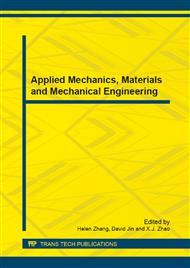[1]
Asakura, T., Sato, Y., Mountain tunnels damage in the 1995 HYOGOKEN-NANBU Earthquake. Quarterly Report of RTRI, 39 (1), 9-16 (1998).
Google Scholar
[2]
Chang, C.T., Chang, S.Y., Preliminary inspection of dam works and tunnels after Chi-Chi Earthquake. Sino-Geotechnics, 77, 101–108 (2000).
Google Scholar
[3]
Yuan Y.F., Impact of intensity and loss assessment following the great Wenchuan Earthquake. Earthquake Engineering and Engineering Vibration, 7 (3), 247–254 (2008).
DOI: 10.1007/s11803-008-0893-9
Google Scholar
[4]
Wang W.L., Wang T.T., Su J.J., Lin C.H., Seng C.R., Huang T.H., Assessment of damage in mountain tunnels due to the Taiwan Chi-Chi Earthquake. Tunnelling and Underground Space Technology, 16(3), 133–150 (2001).
DOI: 10.1016/s0886-7798(01)00047-5
Google Scholar
[5]
Wang Z. Z, Gao B., Jiang Y.J., Yuan S., Investigation and assessment on mountain tunnels and geotechnical damage after Wenchuan earthquake. Science in China Series: Technological Sciences, 52 (2): 546–558 (2009).
DOI: 10.1007/s11431-009-0054-z
Google Scholar
[6]
Pakbaz M.C., Yareevand A., 2-D analysis of circular tunnel against earthquake loading. Tunnelling and Underground Space Technology, 20(5), 411–417 (2005).
DOI: 10.1016/j.tust.2005.01.006
Google Scholar
[7]
Kazuo K., Data archives of seismic fault-induced damage. Soil Dynamics and Earthquake Engineering, 25(7–10), 559–570 (2005).
DOI: 10.1016/j.soildyn.2004.11.009
Google Scholar
[8]
Jiang Y., Wang C., Zhao X., Damage assessment of tunnels caused by the 2004 Mid Niigata Prefecture Earthquake using Hayashi's quantification theory type II. Natural Hazards, 53(3), 425–441 (2010).
DOI: 10.1007/s11069-009-9441-9
Google Scholar
[9]
Reddy C. D., Arora S. K., Sunil P. S, Prajapati S.K., Earthquake related deformation cycle: perspectives from 2004 sumatra and 2010 Chile Mega-earthquakes. Disaster Advances, 4(2), 13–21 (2011).
Google Scholar
[10]
Li T. Damage to mountain tunnels related to the Wenchuan earthquake and some suggestions for aseismic tunnel construction. Bulletin of Engineering Geology and the Environment. 71, 297–308(2012).
DOI: 10.1007/s10064-011-0367-6
Google Scholar
[11]
Free M., Rossetto T., Peiris N., Zhao B., Koo R., Wang J., Ma X., Verrucci E., The Wenchuan, China Earthquake of 12 May 2008: a Preliminary Field Report by EEFIT. http: /elsa. jrc. ec. europa. eu (2008).
Google Scholar
[12]
Adem O., The relationship between earthquake knowledge and earthquake attitudes of disaster relief staffs. Disaster Advances, 4(1), 19–24 (2011).
Google Scholar


